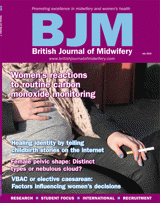Food consumption in British Pakistani v British White babies
A study undertaken in Bradford found that British Pakistani infants consume more chips, sugar-sweetened drinks and commercial sweet baby meals than their British White counterparts. The study monitored the diets of more than 1250 young children through a food frequency questionnaire, which was completed by their parents when each child was 12 and 18 months old. Pakistani infants at 12 months old consumed more chips, roast potatoes, commercial sweet baby meals, sugar-sweetened drinks and fewer processed meat products than White British infants. These differences persisted and increased. Consumption of fruit and vegetables was higher in Pakistani infants but the difference was reduced by 18 months. The researchers suggest that interventions to encourage parents to reflect on diet should commence during the antenatal period.
Midwives are ideally placed to begin this dialogue with pregnant women, alongside the benefits of breastfeeding.
Benefits of exercising in pregnancy
Women who exercise moderately during pregnancy can cut their risk of developing gestational diabetes and limit their weight gain. In this systematic review, the research team from Spain looked at the results of enrolling healthy pregnant women, who did little or no exercise, into exercise programmes. A systematic review of 13 studies, involving more than 2800 women, found that exercise reduced the risk of gestational diabetes by more than 30%—for women who exercised throughout pregnancy this was even greater (36%). This effect was strongest for women who combined toning, strength, flexibility and aerobic exercise. The review highlighted that exercise reduced excessive weight gain in women. Those women who did exercise were, on average 1 kg lighter. This was also found if women who started an exercise programme in the second trimester.
Caution may be required when reading this study as the findings are contrary to the most recent Cochrane review, which concluded that evidence for reduction in gestational diabetes with increased physical exercise is lacking (Han et al, 2012). However, one can argue that it really is not rocket science that if moderate exercise is undertaken during pregnancy then women will limit their weight gain.
Association between duration of rupture of membranes and mother-to-child HIV transmission rates
A study of 2398 pregnant women set out to investigate the association between duration of rupture of membranes and mother-to-child HIV transmission rates in women who are taking combination antiretroviral therapy. Results show that there was a low risk (0.46%) of mother-to-child HIV transmission, for babies born to mothers who are HIV-positive and who are taking combination antiretroviral therapy. This was unrelated to length of time between waters breaking (rupture of membranes) and birth. This study has implications for clinical practice, as for many years clinicians have avoided rupturing membranes of women who are HIV-positive during labour. This was due to the reported increase of HIV transmission in women with a CD4 count of <20% and with >4 hours during of ruptured membranes (Minkoff, 1995).
This study supports the conclusion that the duration of the ruptured membranes is not an independent risk factor for the transmission of HIV in women taking combination antiretroviral therapy. While no women should have an artificial rupture of membranes in early labour unless indicated, this study provides reassurance for those women who are HIV-positive on combination antiretroviral therapy and who present with prolonged rupture of membranes or who require an artificial rupture of membranes for prolonged labour.

